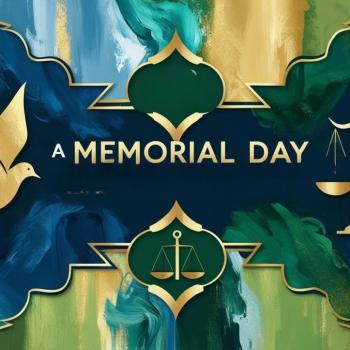by Amer Aziz
Dr. Nabeel Qureshi, the indefatigable Christian apologist who succumbed to cancer just recently at the tender age of 34, had piqued my interest.
In 2010, I converted from orthodox Islam into the Ahmadiyya Movement in Islam—a 19th century revivalist and missionary movement founded by Mirza Ghulam Ahmad (1835-1908) who Ahmadi-Muslims believe to be the allegorical Second Coming of Christ. As I grew familiar with my new community of believers it was impossible not to come across Nabeel’s story– a few years earlier, Nabeel, a born Ahmadi, had converted out and into Christian orthodoxy.
People who convert usually spend a good deal of time studying and scrutinizing theology, and prophecy. Naturally, I was drawn to what arguments and convictions had motivated Nabeel the other way. That would not prove to be difficult. Dr. Nabeel Qureshi, a darling of his new Christian community, was an incessant apologist and proselytizer who churned videos, blogs, books and pulled large crowds as a speaker while pursuing PHDs in religion.

Apologists, however, are viewed cautiously by people in general. An apologist is someone who prepares defense and counter-arguments on controversial aspects of their religion, sometimes with logical and theological acrobatics. They have rehearsed responses to your questions and objections. They are looking to hook you in, and eventually gain your conversion. Naturally, apologists end up getting drawn into debates with apologists of other religions competing for the world’s hearts, souls and minds. Nabeel and I traded briefly on the blog debate-floor. He presented his argument on Islam & ISIS, and I defended— fair enough, let the readers judge for themselves.
But sometimes, the intense study and scrutiny behind apologetics can lead to positive outcomes such as correcting an irrational and flawed position or theology. Nabeel was relentless in hammering an irrational and questionable interpretation common among orthodox Muslims on the crucifixion of Jesus Christ. Chapter 4 verse 158 of the Quran states: And their saying, ‘We did kill the Messiah, Jesus, son of Mary, the Messenger of Allah, whereas they slew him not, nor crucified him, but he was made to appear to them like one crucified. Some Muslim commentators had put forth the idea that Jesus was never put on the cross, instead he was substituted by someone else made to look like him, while the real Jesus was lifted up to heaven by angels.
However, as Nabeel Qureshi pointed out, this interpretation is highly problematic. It implies that God willfully deceived onlookers that Jesus died on the cross affirming the position of the Jewish orthodoxy that he could have been the messiah having died an accursed death (Deuteronomy 21, 22-23), and also thus creating a false Christian theology that Jesus died and then came back to life to be raised up to heaven.
Mirza Ghulam Ahmad has stated that the correct and rational interpretation of this verse is that Jesus had fallen into a swoon on the cross, was rescued and nursed to health in three days. He used the New Testament as support such as in John 19:39-40 when two prominent supporters of Jesus, Joseph of Arimathea and St. Nicodemus, bring large amounts of Aloe and Myrrh herb after removing Jesus from the cross. The writer of the Gospel of John assumes the herbs must be for a Jewish embalming and burial custom. But as author and esoteric scholar of religion, Holger Kirsten, points out– there is no such Jewish custom nor embalming process: Rabbanic texts refer only to the external oiling of the bodies, the addition of spices is nowhere mentioned: it was never part of Jewish customs, and nor was embalming…one can only conclude that the writer of this verse had no idea of Jewish burial rites, and knew nothing about embalming either. Whatever Joseph and Nicodemus were doing had nothing to do with Jewish burial rites.
In fact, Aloe and Myrrh are known in the annals of medicine as herbal-applications that were used for healing wounds. This would agree with a historical text known as A Letter Written Seven Years After The Crucifixion By A Personal Friend Of Jesus To An Esseer Brother In Alexandria. On page 73 of the text St. Nicodemus is quoted saying: Dear friends, be of good cheer, and let us go to work, Jesus is not dead, he seems so as his strength is gone.
This grave contradiction in John 19:39-40 can be explained by virtue of academic and historical analysis that the early development of Christianity was a Hellenized version of Jesus’s teachings developed by St. Paul in the Greek diaspora outside Jerusalem. This analysis has been advanced by modern scholars such as Reza Aslan and Bart Ehrman. The writer of John 19:39-40 was probably complying with a Hellenic theology of Jesus’s literal death and resurrection, and must have wrongly assumed the herbs were for a Jewish embalming ritual.
As for orthodox Muslims, they too have addressed this Christian-apologist objection of the shape-shifter theory of someone else being planted and crucified as Jesus. Dr. Shabbir Ally, one of the better known orthodox Muslim apologists took up the subject during a debate with Christian apologist Michael Licona where he exposed research that this theory has no basis in original Islamic texts and scholarship. Classical Islamic scholars such as Zamakshari and Razi had both called out this problematic interpretation. Scholar Neal Robinson in his book, Christ in Islam and Christianity, traced these irrational commentaries to fourth century Iraq when rampant conversions to Islam led to the import of this theory found in some early Christian gnostic texts. The Gospel of Barnabas, for example, states it was Judas Iscariot who was crucified instead of Jesus.
Nabeel Qureshi also pounded hard on the contemporary phenomenon of extremism and violence with groups such as ISIS, suggesting it is rooted in core religious teachings and the example of prophet Muhammad. This allegation motivated me to look into historical scholarship of the events and politics of Muhammad’s time. After some research I penned a detailed response to the allegation. Based on academic research by Peter Frankopan, director of Byzantine studies at Oxford, a protracted war of religion between the super-powers of Rome and Persia had left little value in freedom of thought, conscience and religion. Freedom of religion was an early feature of Muhammad’s governance at Medina and per Peter Frankopan: cohabitation of faiths was an important hallmark of early Islamic expansion, and an important part of its success.
Ironically, this allegation can be easily refuted by surviving documents known as Covenants with the Christians authored by Prophet Muhammad himself. The covenant ensures the rights of Christians to practice their religion freely and stipulating the covenant to hold until the very end of the world.
Nabeel Qureshi wasn’t just a bare apologist shouting out to accept Christ as our savior or be damned to hell for eternity. He was acutely academic and research-oriented, even if in my opinion he was wrong. Thanks in part to Nabeel, the fiercely competitive field of apologetics, with its draw on academic analysis, holds promise for rational and informed alignment of religious beliefs.
Rest in peace, Nabeel.













